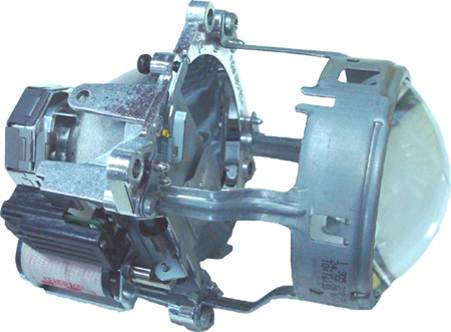Lighting
.jpg)
Lighting TechnologiesThe evolution of the modern headlamp has increased the comfort of drivers and the safety of all road users. But the array of technology can leave some people confused. Lighting market leader Lucas explains the science behind the jargon. High Intensity Discharge (HID) No longer the preserve of sports cars, HID or Xenon systems are now being integrated into medium family saloon cars. HID systems can produce 200% more light than a standard halogen bulb. They also have more than double the lifespan compared to a standard halogen unit. The light produced is similar to daylight and is adapted to the natural viewing conditions of the eye.
The function of the DRL is to allow the illumination of the headlamp at all times regardless of the prevailing light conditions. This has been proven to reduce road traffic accidents by 3-5%. The technology comes in different forms: from the use of a standard bulb (either the main, low beam or fog lamp bulb illuminated at a reduced intensity during daylight hours), or a dedicated DRL bulb or lighting system such as LED integrated into the headlamp and illuminated during daylight hours. Adaptive Front Lighting System (AFS) AFS was introduced to the market by Citröen with a crude system that moved the headlamp beam when the steering wheel was turned. Today’s AFS systems adjust the beam to the course of the road using dynamic actuators triggered by the movement of the steering wheel or GPS system. As the vehicle’s steering angle changes the light of the low beam is swivelled horizontally to effectively “look around” the bend, increasing the light on the road by 70%. During motorway driving the beam is projected further down the road to improve the illumination range from 130 to 160 metres. At slower speeds the beam can be enlarged to cover a greater proportion of the verge from 30º to 60º. Rear lamp designs can also have adaptive lighting technology which uses the force applied to the brake pedal to illuminate the lamp more brightly when strong braking occurs. Polyellipsoidal
Light Emitting Diodes (LED) The LED system is based on semiconductor technology which has many advantages over standard bulb technology. Lower energy consumption is achieved with LED lighting due to the efficient conversion of electrical power. On rear lamp applications the response is 0.2 seconds quicker than standard incandescent bulbs, which equates to an extra 19 feet of response time when travelling at 65mph. Finally, the lifespan of an LED bulb can reach 100,000 hours. There are some limiting factors preventing mass production such as regulatory delay and technical issues. LEDs produce a significant amount of heat per unit of light output and heat can reduce the unit’s lifespan. To maintain the lifespan at high power output levels a heat management system is required. This may be a heat sink or cooling fan but these can be expensive solutions. Overview: Lucas Lighting & Mirrors
For more information on lighting technologies, please see the lighting technologies guide here. |
Related Articles Related Downloads |
 Daylight Running Lights (DRL)
Daylight Running Lights (DRL)  Polyellipsoidal, or projector lamps, use a condenser lens (which looks like a magnifying glass), behind which is situated the light source. In between the lens and the light source is a plate or shield that has an angled cut providing the low beam cut off and the 15º angle of kick up to the kerb side. Some lights use a solenoid to pivot the shield to create a high beam and this system is called Bi-Xenon or Bi-Halogen depending on which light source is used. Later versions of the condenser lens also allow light to be directed upwards to illuminate traffic signs.
Polyellipsoidal, or projector lamps, use a condenser lens (which looks like a magnifying glass), behind which is situated the light source. In between the lens and the light source is a plate or shield that has an angled cut providing the low beam cut off and the 15º angle of kick up to the kerb side. Some lights use a solenoid to pivot the shield to create a high beam and this system is called Bi-Xenon or Bi-Halogen depending on which light source is used. Later versions of the condenser lens also allow light to be directed upwards to illuminate traffic signs.